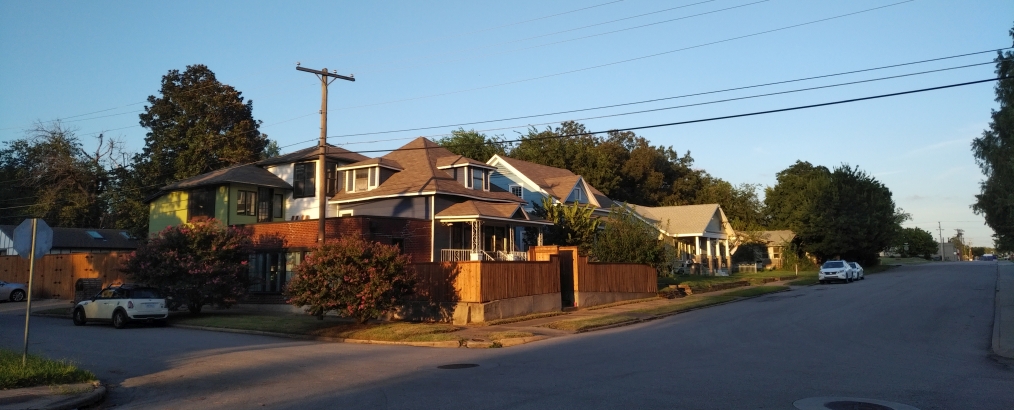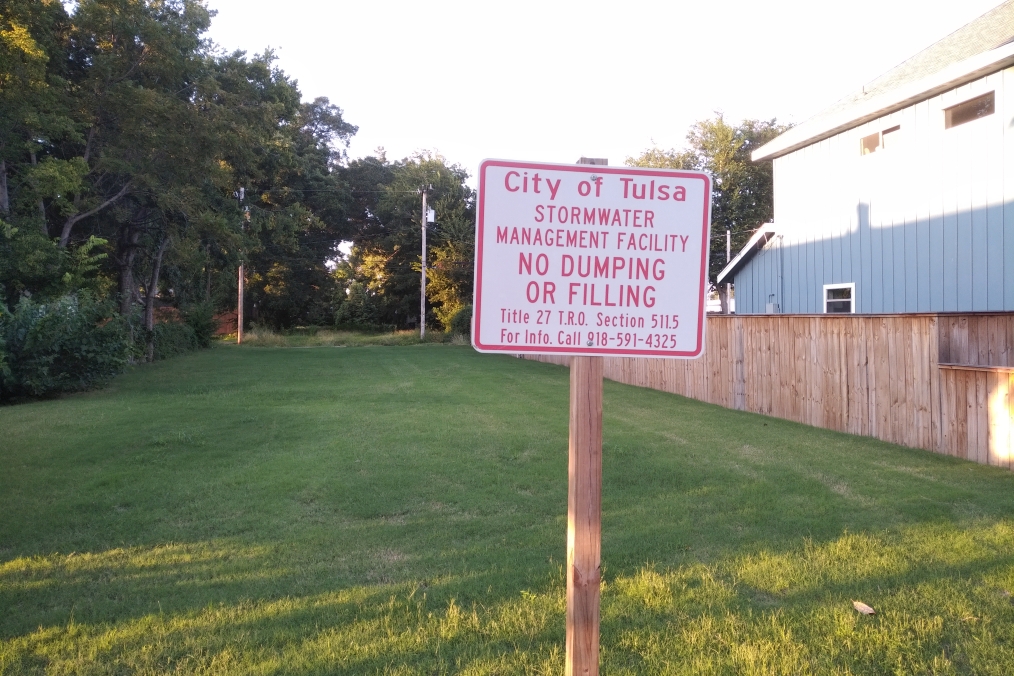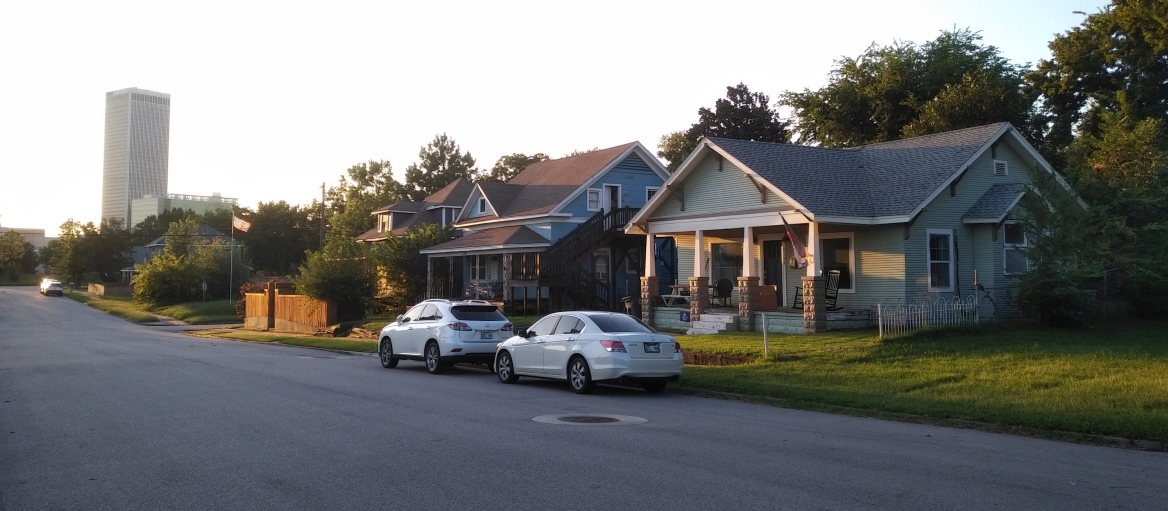Saving Paul Harvey's neighborhood: Next steps

I had to be downtown last night, and I decided to go for a walk. On a whim, I walked under the east leg of the IDL to Paul Harvey's old neighborhood, which the City of Tulsa is acquiring, lot by lot, house by house, to convert to a stormwater detention pond.
I took some pictures along Madison Avenue, and then on 5th Place. I noticed that several homes were well cared for and recently updated. I also noticed that the city had already placed a metal sign in each of several vacant lots that they had already purchased, declaring each lot a STORMWATER MANAGEMENT FACILITY.

While I was in the neighborhood, I had the chance to chat with the Dawsons, the family whose home has been condemned by the city for the planned Elm Creek West Pond. Their investment in improving their new home, inside and out, was evident. Before they moved in, the house had been used to store restaurant equipment.
At the moment, it appears that only a couple of homes are in the condemnation process. My guess is that the city was pursuing a strategy of picking off one home at a time in order to avoid mobilizing the neighborhood to organize.

The Elm Creek West Pond is a zombie project. Bureaucratic inertia is at work. At some point in the past, the project was deemed worthwhile and was added to a list of capital improvements, at which point it went into hibernation. When the funding finally arrived, after over a decade, it lurched back to life, without any reexamination or reconsideration. Is it still necessary? Is it still the best way to accomplish the goal?
From Engineering Services' perspective, they're just following a plan. The people responsible for adjusting the plan to changing circumstances, the City Council, just sits there and nods.
The City Council has the power to stop this zombie. The City Council has the power to put land acquisition on pause while the necessity of the project is reviewed and alternatives are considered.
In reply to a Preserve Midtown Facebook post about this situation, Amanda DeCort, executive director of the Tulsa Foundation for Architecture, wrote:
Ye Olde Unfunded Stormwater Project has been keeping the residential areas in the Pearl District down for 20 years. Neighborhood de-stabilization. And still no funding. Ridiculous. It's a shame the City won't rethink this. Hard to believe there's not another patch of dirt to put a pond on.
Some questions that ought to be asked before this project is allowed to proceed any further:
- How much property damage would be averted in a 100-year-rainfall event if this pond is built? Would it be cheaper just to pay for repairs if a flood occurs?
- Are there more localized improvements that could protect particularly vulnerable or valuable buildings? For example, the SpiritBank (originally Mapco) building at 18th and Baltimore has a large vacant area just upstream, to the north across 18th St, that could be used for stormwater retention. And I can't help but notice a great deal of unusable open space in the shadow of the the southeast interchange of the Inner Dispersal Loop.
- How many acre-feet of additional storage is really needed, given the capacity of the Centennial Park lake and other changes in the watershed since the original study was done 30 years ago?
- Wouldn't it be better for minimizing stormwater runoff if we kept the single family homes, each with a yard that can soak up rainfall, rather than replace them with the high-density, no-open-space development shown in the artist's conception of the pond?
- How much improvement could be obtained by funding the replacement of impermeable parking lots -- like the big ones surrounding the Indian Health Care Resource Center (IHCRC) and VFW buildings -- with permeable paving solutions.
- Why not use the large chunks of already vacant land in the neighborhood to build smaller detention ponds, rather than demolish more homes? For example, 2/3rds of the block northeast of 5th Pl and Owasso is an unpaved grassy lot -- some of it owned by the City of Tulsa, some by the IHCRC. Another large grassy lot stands northeast of 5th Street and Owasso, owned by IHCRC. That's enough land to make up for the homes that would not have to be acquired -- assuming all that storage capacity is truly required.
After gathering all of the information, the City Council has the discretion to weigh competing concerns against each other. Even if the entirety of the engineer-decreed stormwater capacity can't be obtained through alternative means, it's OK for the Council to decide that the residual flooding risk is more acceptable than the loss of a neighborhood.
Protecting the remaining historic homes in the neighborhood, guaranteeing these urban pioneers the stability they need to invest further in their properties, reweaving the urban fabric that connects the East Village to the 6th Street corridor, the new Studio District, Whittier Square, and the TU campus -- these are goals that ought to outweigh marginal improvements in stormwater capacity.
Councilor McKee, come out to 5th Place and meet with these homeowners. Bring some council colleagues along, then see for yourselves what they've done to renovate their homes. Listen to their vision for the future of their neighborhood. Then call a halt while there's still time.
MORE LINKS:
April 7, 2016, agenda for the Tulsa Development Authority, noting receipt of "Elm Creek/6th Street Drainage Detention and Conveyance Plan" from Roger Acebo. (The executive session was to include a discussion with counsel concerning the Redevelopment Agreement dated June 30, 1986, between the University Center at Tulsa and the Tulsa Development Authority. It was under this agreement that TDA acquired and razed the Near Northside neighborhood for future campus expansion that will never happen.)
September 1, 2016, report from Roger Acebo to the TDA regarding the 6th St. Infill Acquisition/Relocation Plan. The report provides this summary of the project. Note that the listed funds are barely enough to acquire the "interested owner parcels," much less all 153, and that leaves no money for actually building the pond.
- Acquisition of properties are considered voluntary in nature.
- There are not enough available funding to purchase all 153 parcels in the two locations (West Pond / East Pond concept); therefore, acquisitions are occurring as property owners express interest through responses from direct mailings and/or telephone contact.
- 23 properties are under City ownership at the two locations.
- 24 properties are actively being processed for acquisition consideration due to owner interest.
- 106 properties not being processed due lack of full funding, not ready to sell, or apparent lack of interest.
- Expenditures for this project shall be paid out of previously identified and associated City sales tax:
- Improve Our Tulsa (6014-5451101-040522-148150) balance - $974,150.00
- 2006 Street Package (063106) balance - $1,325,178.00
- Current estimated acquisition costs of the 24 interested owner parcels: $1,380,085.00.
Here's Roger Acebo's June 1, 2017, update to TDA, dealing specifically with the acquisition of the bus garage NW of 5th St. and Owasso Ave. from Wiltom Enterprises.
- Acquisitions are being conducted as voluntary in nature.
- All acquired properties will eventually be incorporated into a flood management design or future redevelopment project by TDA on behalf of the City.
- 153 total parcels are identified in plan area. Of these:
- 119 parcels are not being processed either due to lack of full funding, not ready to sell, or apparent lack of interest.
- 23 parcels are under City ownership at the West pond and East pond locations.
- 1 additional property owners have shown interest in selling.
- 10 parcels have now been acquired by TDA.
- 1 home to be scheduled for demolition.
- Of 6 tenants in acquired properties:
- 5 have been relocated
The City Council recently dealt with another condemnation on the same block, a renovated home with a separate apartment at 1408 E. 5th Street. The final pages have a screenshot of a "Project Expense Inquiry" which shows project 148150: Pearl District Flood Control as having a budget of $4,383,276.43, with $1,261,207.05 already spent as of July 29, 2019. Why spend the money to acquire land if you don't have money to build the project?
Note that in 2016 and 2017, acquisitions were "being conducted as voluntary in nature." When did the switch get flipped to compulsory acquisition?
0 TrackBacks
Listed below are links to blogs that reference this entry: Saving Paul Harvey's neighborhood: Next steps.
TrackBack URL for this entry: https://www.batesline.com/cgi-bin/mt/mt-tb.cgi/8528